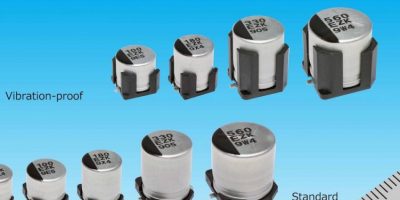Capacitance reduces the number of capacitors required, says Panasonic
Large-capacitance conductive polymer hybrid aluminium electrolytic capacitors will be available from Panasonic next month. The increased capacitance will enable a reduction in the number of capacitors necessary and compact size, contributing to the downsizing of automotive electronics control units (ECUs), says the company.
The ZKU series of large-capacitance conductive polymer hybrid aluminium electrolytic capacitors have increased capacitance compared to the earlier ZC series. The largest measures 10 x 10.2mm and smallest is 5.0 x 5.8mm.
Conductive polymer hybrid aluminium electrolytic capacitors feature low resistance and high reliability through the fusion of conductive polymer and electrolyte and are used in a wide range of applications, from control circuits in automotive engine ECUs, battery management systems (BMS) to motor drive circuits in electric pumps, radiator fans, and further to advanced driver assistance systems (ADAS) applications, such as cameras, sensors, and control circuits. The electrification of automobiles has led to redundant design aiming to improve the safety and reliability. More ECUs are used in a single car, due to the mounting of two identical ECUs, for example. Design for downsizing boards is necessary for securing mounting space, which requires reductions in the number and size of capacitors and large current.
Panasonic has commercialised the ZKU series of conductive polymer hybrid aluminum electrolytic capacitors with the industry’s largest capacitance by using its electrode foil large-capacitance technology. This enables a reduction in the number of required capacitors, from the use of several capacitors in parallel, as well as reduction in the size of capacitors with the same rating, thereby contributing to board downsizing.
They have 50 per cent or more capacitance than existing ZC series capacitors and 20 per cent or more capacitance larger than the ZK series products.
These capacitors maintain the large current and high reliability of the conventional products, contributing to board area reduction. They have achieved large currents, i.e., 1.3 times as much as those of the conventional ZC series products and equivalent to those of the ZK series.




